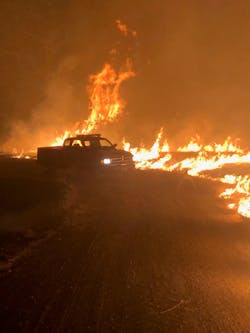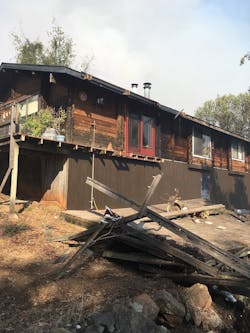Fighting Fire within the Wildland Urban Interface
On Oct. 15, 2017, I was assigned as a line safety officer on the LNU Lightning Complex. I was working within a division of the Nuns Fire and was assigned to an area within the Highway 12 corridor east of Santa Rosa, CA.
Fire behavior was active, as the fire burned through Hood Mountain and continued to progress east and south toward residential areas. The division group supervisor prioritized constructing direct lines and protecting structures. The division was complex and spanned from the valley floor up into the mountains.
As I scouted the division, it was apparent that we would find ourselves in a structure-protection mode as the fire continued to progress toward the valley. The division supervisor and I agreed that I would stay near the valley floor, while he would focus on the structures and direct line construction on the mountain.
In the early afternoon, I made my way up a tight rural road and, to my surprise, found multiple houses. As I traveled up the road toward the fire, the area became more rural, and the houses dissipated. It was clear that the fire behavior had increased as it marched toward my direction.
This situation is one that wildland firefighters in California find themselves in often: It was decision-making time. With limited resources and the safety of firefighters the top priority, I started my risk analysis process, developed strategies and implemented wildland urban interface (WUI) tactics (see “Wildland Urban Interface Tactics” below).Residences & firefighter risks
I decided to implement the WUI Fire Front Following tactic, which meant that we would leave the area and wait for the fire front to pass.
Within the lower half of the road, where houses were closer together and had better clearances, the WUI Prep and Defend strategy was implemented: Firefighters stayed put and defended structures that were believed to be savable.
Because there was some time before the fire threatened the lower houses, I instructed a hand crew to create a fire break to do some defensive firing, if needed.
Fast forward a few hours: As expected, the fire progressed through the area of the upper houses. The hand crew had completed some defensive firing, and firefighters actively engaged in saving the lower residences. A strike team of engines and I raced up the road toward the upper houses and immediately began to try to save as many of them as possible. We were successful with some. Unfortunately, as is the case with every firefighting tactic, building construction and clearance played a large role.
On PACE
Wildland firefighters in California have experienced immense challenges over the past decade. With prolonged droughts, intense heat waves and relentless wind events, they fought some of the largest and most destructive fires ever. The Camp Fire (November 2018) burned 153,336 acres and 18,804 structures and killed 85 people. The Tubbs Fire (October 2017) burned 36,807 acres and 5,636 structures and took 22 lives.
Relentless wind events have been a significant contributor to the rapid spread and destructiveness of most of these extreme fires, and firefighting forces must make on-the-fly decisions. In some cases, firefighters have been helpless and often forced to evacuate as many people as possible and then get out of the way. In those moments, lives are on the line, and the best decision is to let the beast do its thing and re-engage when the door reopens.
As houses continued to be built within the country setting in the late 2000s and early 2010s, in October of 2013, Firescope California produced the Wildland Urban Interface (WUI) Structure Defense document. It now is studied and preached by wildland firefighters consistently.
By utilizing the PACE (Primary, Alternate, Contingency, Emergency) tactical engagement process of risk management, firefighters can make tactical decisions that produce the highest probability of success while prioritizing their safety and the public’s safety.
Often, firefighters get caught up in the moment and focus on the primary plan. The “candle moth” syndrome is real and can happen often on these incidents. The PACE model was designed to remind decision-makers to focus on the bigger picture and to have multiple plans in place. What happens when the primary plan doesn’t work? Do you just keep charging forward with a plan of action that will continue to deliver negative results? The answer, of course, is no, but when the mind and body are stressed, an individual tends to lock in and often forgets to re-evaluate actions and to make changes.
The PACE model helps you to re-evaluate and to put multiple plans in place. This way, everyone knows what to do when the primary plan doesn’t work or if adjustment is required. Much like an audible from a quarterback, the alternate plan is the backup play call.The contingency plan is there for when the primary and secondary plans no longer are options. At the Nuns incident, our contingency plan if aggressive tactics didn’t work or if the fire behavior changed was for all firefighters to pull back to Highway 12 and to make a stand at that roadway.
The emergency plan at the Nuns incident: Everyone on the incident regroup to a safety zone at a shopping center parking lot. There, everyone would be safe and out of harm’s way if things escalated to a point where objectives couldn’t be met because of extreme fire behavior and major changes in conditions.
To simplify this document and to relate it to my situation on the Nuns Fire, consider this: First and foremost, I needed to gather intel and determine the values that were at risk. After an assessment, I found multiple evacuated houses. When civilians are in the fire area, the level of risk changes. After the civilians were evacuated, my values at risk were the houses.
My risk analysis helped me to determine that firefighter safety was jeopardized within the upper half of the road, hence the decision to Go. In contrast, regarding the structures that were situated on the lower half of the road, I felt comfortable to Stay and to implement Prep and Defend. A quick assessment allowed me to implement a PACE model that was disseminated to the rest of the firefighters on the division, and they immediately engaged and went to work.
Reading is fundamental
As we study close calls and firefighter injuries/fatalities, we must evaluate our decisions and determine whether our actions were the best for that situation. Risking a lot to save a lot is a core value of this profession, but what does “save a lot” mean? Risking your life to save another life is one thing, but no firefighter’s life is worth a house.
To keep firefighters safe, they must study and implement the risk analysis process and use the PACE model.
Now more than ever, firefighters choose Go based on their risk analysis and the implementation of Fire Front Following and Tactical Patrol. This culture of knowing when to “fold the cards” and get out of the way is vitally important to the safety of our firefighters.
Choosing tactics and strategies during these fast-moving fires can be overwhelming and extremely stressful. By simplifying decision-making by using the risk-assessment tool and the PACE model, reliable decisions that focus on civilian and firefighter safety are possible.
Simplifying the seven WUI tactics into Stay or Go is helpful, because once you determine whether to Stay or Go, you can determine which of the other five tactics fits best. We took an oath to serve. Part of that oath is to study our craft and to be as educated and experienced as possible when making decisions on saving lives, including our own.
Wildland Urban Interface Tactics
There are seven identified wildland urban interface (WUI) firefighting tactics within our scope. Because seven tactics can be overwhelming, it’s worthwhile to separate the tactics into two categories: Stay and Go.
When your risk analysis allows you to Stay, then Prep and Defend, Anchor and Hold, and Bump and Run are your options. When it’s time to Go, then choices are Check and Go, Prep and Go and Fire Front Following. (Fire Front Following is a necessity to any fire that moves through the interface when firefighters choose to move out of the area because of the risk.)
The last of the seven WUI firefighting tactics is Tactical Patrol. This is the most important of all of the tactics, because many houses burn after the fire front passes. Patrolling the neighborhood for multiple days prevents unnecessary loss.

Chad Costa
Chad Costa is the assistant chief for the Petaluma, CA, Fire Department. With more than 26 years of fire service experience, he has worked in various organizations, including CAL FIRE, rural and semi-rural districts, and a city. As a battalion chief, Costa was the technology and communications battalion chief. He is now a rostered operations branch director for CalFire Team 1 and an alternate operations section chief trainee on California Interagency Team 5. Costa is an accredited Chief Fire Officer through the Center for Public Safety Excellence and has a bachelor’s degree in emergency services management, a master’s degree in fire service leadership, and a certificate in homeland security. Costa has also completed the Executive Chief Officer Program at the National Fire Academy. Costa is a member of the Firehouse Editorial Advisory Board.
![According to Firescope California’s Wildland Urban Interface (WUI) Structure Defense guide, “Structure defense firefighting in the [WUI] is inherently dangerous, because it is primarily associated with in-direct firefighting.” It adds that in-direct firefighting safety mitigations depend on fire behavior that’s made in advance of the fire’s arrival, but, of course, accurate fire behavior forecasts are difficult to make. “Firefighters must anticipate the unexpected and build agility … into their plan with contingency planning,” or PACE (primary, alternate, contingency and emergency plans). According to Firescope California’s Wildland Urban Interface (WUI) Structure Defense guide, “Structure defense firefighting in the [WUI] is inherently dangerous, because it is primarily associated with in-direct firefighting.” It adds that in-direct firefighting safety mitigations depend on fire behavior that’s made in advance of the fire’s arrival, but, of course, accurate fire behavior forecasts are difficult to make. “Firefighters must anticipate the unexpected and build agility … into their plan with contingency planning,” or PACE (primary, alternate, contingency and emergency plans).](https://img.firehouse.com/files/base/cygnus/fhc/image/2021/02/16x9/mar_21_wildland_FF_strategies_pic_1_Nuns_1_v2.6022a567cb2e0.png?auto=format,compress&fit=fill&fill=blur&q=45&w=250&width=250)







